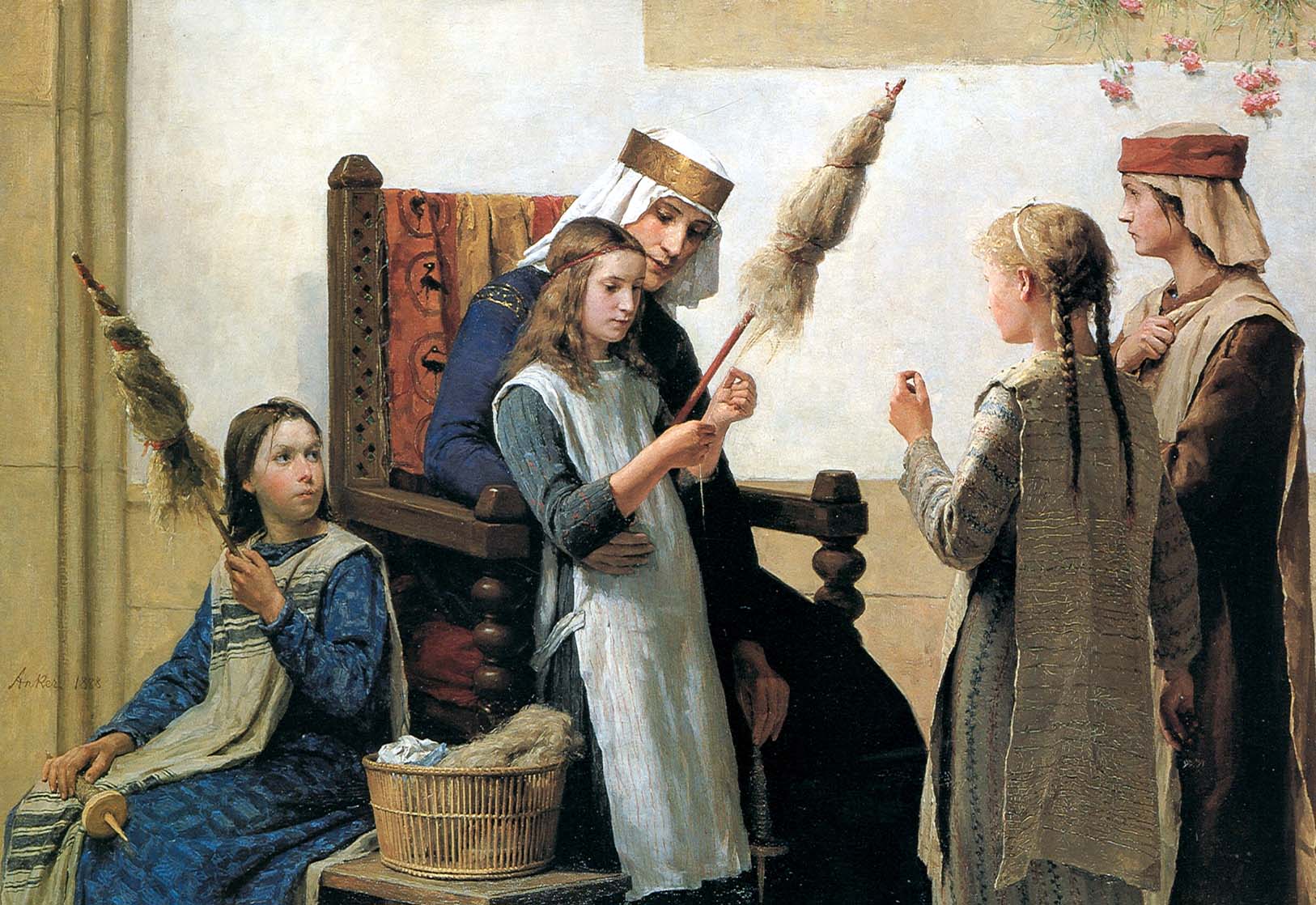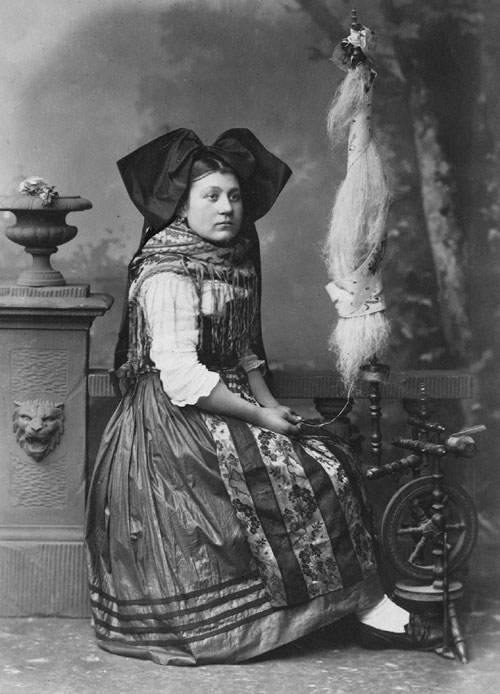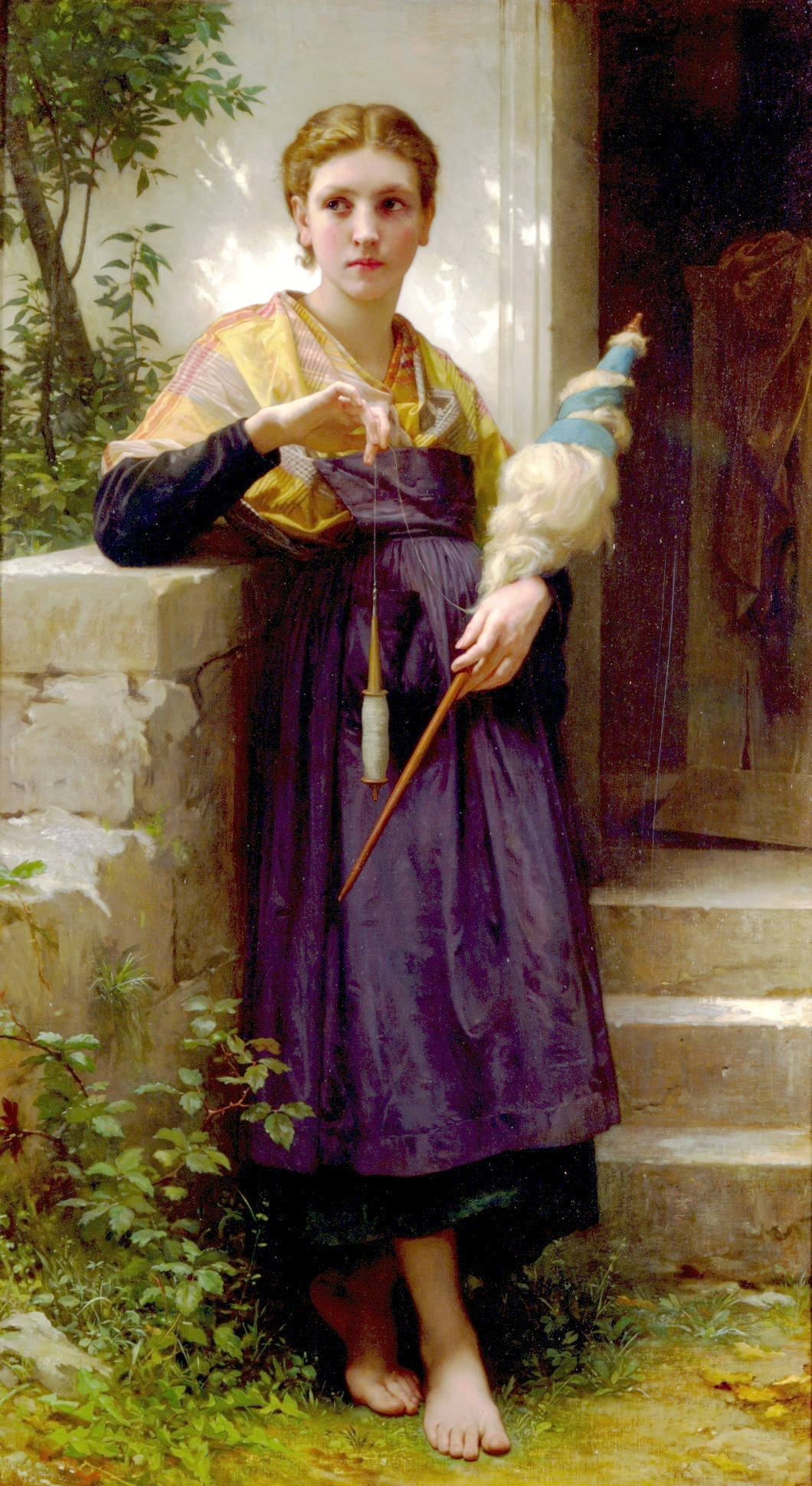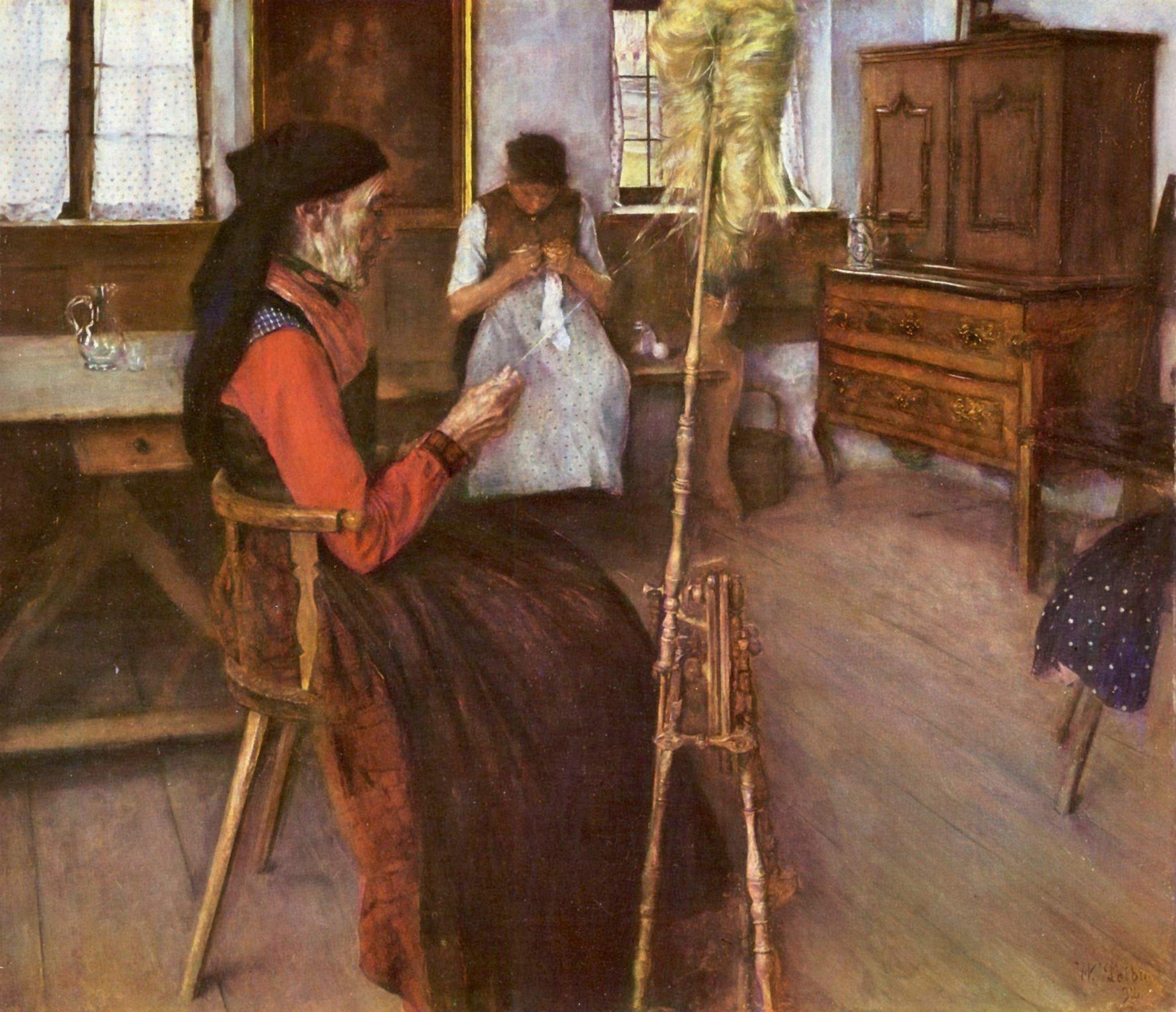Distaff on:
[Wikipedia]
[Google]
[Amazon]

 A distaff (, , also called a rock"Rock." ''The Oxford English Dictionary''. 2nd ed. 1989.), is a
A distaff (, , also called a rock"Rock." ''The Oxford English Dictionary''. 2nd ed. 1989.), is a


 In Western Europe, there were two common forms of distaves, depending on the spinning method. The traditional form is a staff held under one's arm while using a spindle – see the figure illustration. It is about long, held under the left arm, with the right hand used in drawing the fibres from it."Distaff." ''The Oxford English Dictionary''. 2nd ed. 1989. This version is the older of the two, as spindle spinning predates spinning on a wheel.
A distaff can also be mounted as an attachment to a
In Western Europe, there were two common forms of distaves, depending on the spinning method. The traditional form is a staff held under one's arm while using a spindle – see the figure illustration. It is about long, held under the left arm, with the right hand used in drawing the fibres from it."Distaff." ''The Oxford English Dictionary''. 2nd ed. 1989. This version is the older of the two, as spindle spinning predates spinning on a wheel.
A distaff can also be mounted as an attachment to a
 The term ''distaff'' is also used as an
The term ''distaff'' is also used as an
''Loom''s audio drama
which was provided on tape with the game
Instructions on making a recycled-sock wrist distaff
{{Authority control Hand spinning tools Flax Symbols of Athena

 A distaff (, , also called a rock"Rock." ''The Oxford English Dictionary''. 2nd ed. 1989.), is a
A distaff (, , also called a rock"Rock." ''The Oxford English Dictionary''. 2nd ed. 1989.), is a tool
A tool is an object that can extend an individual's ability to modify features of the surrounding environment or help them accomplish a particular task. Although many animals use simple tools, only human beings, whose use of stone tools dates ba ...
used in spinning. It is designed to hold the unspun fiber
Fiber or fibre (from la, fibra, links=no) is a natural or artificial substance that is significantly longer than it is wide. Fibers are often used in the manufacture of other materials. The strongest engineering materials often incorpora ...
s, keeping them untangled and thus easing the spinning process. It is most commonly used to hold flax and sometimes wool
Wool is the textile fibre obtained from sheep and other mammals, especially goats, rabbits, and camelids. The term may also refer to inorganic materials, such as mineral wool and glass wool, that have properties similar to animal wool. ...
, but can be used for any type of fibre. Fiber is wrapped around the distaff and tied in place with a piece of ribbon or string. The word comes from Low German ''dis'', meaning a bunch of flax, connected with staff.
As an adjective
In linguistics, an adjective (abbreviated ) is a word that generally modifies a noun or noun phrase or describes its referent. Its semantic role is to change information given by the noun.
Traditionally, adjectives were considered one of the ma ...
, the term ''distaff'' is used to describe the female side of a family. The corresponding term for the male side of a family is the "spear" side.
Form


 In Western Europe, there were two common forms of distaves, depending on the spinning method. The traditional form is a staff held under one's arm while using a spindle – see the figure illustration. It is about long, held under the left arm, with the right hand used in drawing the fibres from it."Distaff." ''The Oxford English Dictionary''. 2nd ed. 1989. This version is the older of the two, as spindle spinning predates spinning on a wheel.
A distaff can also be mounted as an attachment to a
In Western Europe, there were two common forms of distaves, depending on the spinning method. The traditional form is a staff held under one's arm while using a spindle – see the figure illustration. It is about long, held under the left arm, with the right hand used in drawing the fibres from it."Distaff." ''The Oxford English Dictionary''. 2nd ed. 1989. This version is the older of the two, as spindle spinning predates spinning on a wheel.
A distaff can also be mounted as an attachment to a spinning wheel
A spinning wheel is a device for spinning thread or yarn from fibres. It was fundamental to the cotton textile industry prior to the Industrial Revolution. It laid the foundations for later machinery such as the spinning jenny and spinning f ...
. On a wheel, it is placed next to the bobbin, where it is in easy reach of the spinner. This version is shorter, but otherwise does not differ from the spindle version.
By contrast, the traditional Russian
Russian(s) refers to anything related to Russia, including:
*Russians (, ''russkiye''), an ethnic group of the East Slavic peoples, primarily living in Russia and neighboring countries
*Rossiyane (), Russian language term for all citizens and peo ...
distaff, used both with spinning wheels and with spindles, is L-shaped and consists of a horizontal board, known as the ''dontse'' (russian: донце), and a flat vertical piece, frequently oar-shaped, to the inner side of which the bundle of fibers was tied or pinned. The spinner sat on the ''dontse'', with the vertical piece of the distaff to her left, and drew the fibers out with her left hand. The distaff was often richly carved and painted and was an important element of Russian folk art.
Recently, handspinners have begun using '' wrist distaves'' to hold their fiber; these are made of flexible material, such as braided yarn, and can swing freely from the wrist. A wrist distaff generally consists of a loop with a tail, at the end of which is a tassel, often with beads on each strand. The spinner wraps the roving or tow
Towing is coupling two or more objects together so that they may be pulled by a designated power source or sources. The towing source may be a motorized land vehicle, vessel, animal, or human, and the load being anything that can be pulled. Th ...
around the tail and through the loop to keep it out of the way, and to keep it from getting snagged.
Dressing
Dressing a distaff is the act of wrapping the fiber around the distaff. With flax, the wrapping is done by laying the flax fibers down, approximately parallel to each other and the distaff, then carefully rolling the fibers onto the distaff. A ribbon or string is then tied at the top and loosely wrapped around the fibers to keep them in place.Other meanings
 The term ''distaff'' is also used as an
The term ''distaff'' is also used as an adjective
In linguistics, an adjective (abbreviated ) is a word that generally modifies a noun or noun phrase or describes its referent. Its semantic role is to change information given by the noun.
Traditionally, adjectives were considered one of the ma ...
to describe the matrilineal
Matrilineality is the tracing of kinship through the female line. It may also correlate with a social system in which each person is identified with their matriline – their mother's lineage – and which can involve the inheritance ...
branch of a family, i.e., to the person's mother and her blood relatives. This term developed in the English-speaking communities where a distaff spinning tool was used often to symbolize domestic life. Proverbs 31
Proverbs 31 is the 31st and final chapter of the Book of Proverbs in the Hebrew Bible or the Old Testament of the Christian Bible. Verses 1 to 9 present the advice which King Lemuel's mother gave to him, about how a just king should reign. The r ...
cites the "wife of noble character" as one who "holds the distaff".
One still-recognized use of the term is in horse racing, in which races limited to female horses are referred to as distaff races. From 1984 until 2007, at the American Breeders' Cup, the major race for fillies and mares was the Breeders' Cup Distaff. From 2008 to 2012, the event was referred to as the Breeders' Cup Ladies' Classic. Starting in 2013, the name of the race changed back to ''Breeders' Cup Distaff''. It is commonly regarded as the female analog of the better-known Breeders' Cup Classic, though female horses are not barred from entering that race.
The phrase "on the distaff side" was commonly used by reporters covering athletic competitions when transitioning from men's events over to the highlights of women's events.
In Norse mythology, the goddess Frigg
Frigg (; Old Norse: ) is a goddess, one of the Æsir, in Germanic mythology. In Norse mythology, the source of most surviving information about her, she is associated with marriage, prophecy, clairvoyance and motherhood, and dwells in the wet ...
spins clouds from her bejewelled distaff in the Norse constellation known as Frigg's Spinning Wheel (''Friggerock'', also known as Orion's belt).
In popular culture
* The Women's division of the mixed-martial-arts organization EXC (Elite Xtreme Combat
Elite Xtreme Combat, also known as EliteXC, was a United States-based mixed martial arts (MMA) organization owned and operated by ProElite. It was founded as a partnership between Showtime Networks and ProElite and officially announced on Decemb ...
) is known as the "Distaff Division".
* In the video game '' Loom'' by Lucasfilm Games (1990), the Weavers' Guild, the game's equivalent to wizards, and the main character, Bobbin Threadbare, use wooden staves called "distaffs" to control their magic, with which they "weave the very fabric of reality".which was provided on tape with the game
See also
* Distaff Day *Spindle (textiles)
A spindle is a straight spike usually made from wood used for spinning, twisting fibers such as wool, flax, hemp, cotton into yarn. It is often weighted at either the bottom, middle, or top, commonly by a disc or spherical object called a who ...
* Wand
A wand is a thin, light-weight rod that is held with one hand, and is traditionally made of wood, but may also be made of other materials, such as metal or plastic.
Long versions of wands are often styled in forms of staves or sceptres, which ...
References
External links
Instructions on making a recycled-sock wrist distaff
{{Authority control Hand spinning tools Flax Symbols of Athena